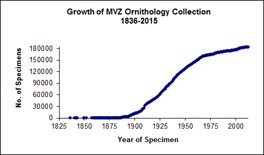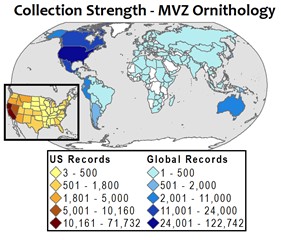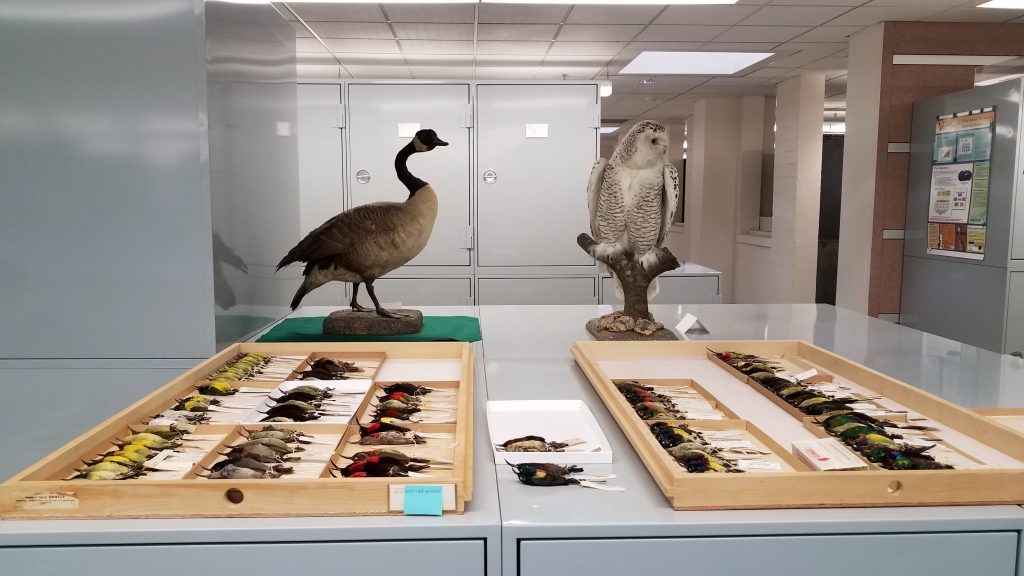Bird Curatorial Manual | About the Collection
About the Bird Collection
The MVZ bird collection is one of the largest in the United States, containing over 195,000 cataloged specimens. In addition, the collection contains over 15,500 egg and nest sets that are cataloged separately. Specimens date to 1836, and the collection has continued to grow steadily since its inception in 1908.
The collection is taxonomically synoptic, with representatives of every recent order of birds. For most orders there is at least 70% representation at the generic level. Although the collection contains specimens from every continent and major ocean in the world, the strength of its geographic representation is western North America, from Alaska and British Columbia southward through southern Mexico. In addition, there are major series of specimens from Central America (especially Guatemala, El Salvador, Costa Rica), South America (in particular, Colombia, Peru, Paraguay, and Argentina), the Hawaiian Islands, the South Pacific, and Australia.

The majority of bird specimens are study skins, but the collection also contains nearly 20,000 skeletal specimens and 3,400 fluid-preserved specimens. Other types of preparations include flat specimens (wings, skins) and body skins without skulls (“schmoos”). Tissues are routinely preserved during the preparation process. Many modern specimens also have anatomical parts (e.g. syrinx, stomach contents), endo/ectoparasites, swabs, and other types of preservations. In addition to the physical collections, the MVZ houses over 6000 audio recordings, many of which are linked to voucher specimens. The collection includes 174 holotypes and two syntypes.

Uses of the MVZ bird collection have changed over the years with advances in research methodologies. Although traditional studies of morphology, geographic variation, and molt continue to make use of the skin collections, more recent uses have focused on destructive sampling of skins for biochemical (e.g., DNA), stable isotope, and contaminant analyses. Requests for such sampling are reviewed carefully and critically by MVZ Curators. Primary uses of the skeletal collections are for comparative study of zooarchaeological or paleontological material, while the anatomical collections are used for systematic, morphological (including CT scanning), and parasitological studies.
The egg collection has been used historically to study the affects of the pesticide DDT on eggshell thinning in birds (e.g., Peregrine Falcons). More recently, the availability of digital photographs of our egg and nest specimens has greatly increased their accessibility for research and education. Researchers have used the digital photographs to study the evolution of egg shape in birds, and to investigate egg recognition by hosts of brood parasites. Additionally, DNA sequences obtained from plant materials in nests of birds from the San Francisco Bay Area have been used to identify plant communities for habitat restoration efforts.
Access to the Collections
All data for the MVZ bird collections is accessible online through the museum’s collection management system Arctos.
Visitors who want to use the collections for research, illustration, or other scientific or educational purposes should contact Staff Curator Carla Cicero (ccicero[at]berkeley.edu) to arrange a visit. Appointments should be made at least two weeks in advance of the proposed visit. See the MVZ website for location and directions.
Any requests for specimen loans or destructively sampling should be addressed to both Carla Cicero and Faculty Curator Rauri Bowie (bowie[at]berkeley.edu). Researchers requesting material should read our policies before making a request.

